Rescripted After a conversation between Moyra Davey and Matthew S. Witkovsky
The following note first appeared in Aperture magazine #217, Winter 2014, “Lit.” Subscribe here to read it first, in print or online.
Literary and personal histories coalesce in Moyra Davey’s elegant works in photography and video. For her ongoing “mailer” projects, begun in 2006 and included in the 2012 Whitney Biennial, Davey folds photographs made with a point-and-shoot camera and printed on durable paper and mails them to various recipients, including family and colleagues; when unfolded and displayed in grid formation on gallery walls, the images, photo-letters marked with sections of colorful tape and postage stamps, bear the traces of transit. Her video works invoke writers, from the transgressive Jean Genet to the nineteenth-century proto-feminist Mary Wollstonecraft, as in Les Goddesses (2011), a piece Davey describes as “a love letter to my family,” and at other moments depict readers’ reactions to passages of writing. In the following conversation, loosely structured as a play, the artist speaks with Matthew S. Witkovsky, curator at the Art Institute of Chicago, about her practice of interlacing photography with literary touchstones, the Norwegian literary phenomenon Karl Ove Knausgaard, with whom Davey shares an affinity for the quotidian, and her work as a writer, which ranges from reflections on photography to personal essays.
—The Editors
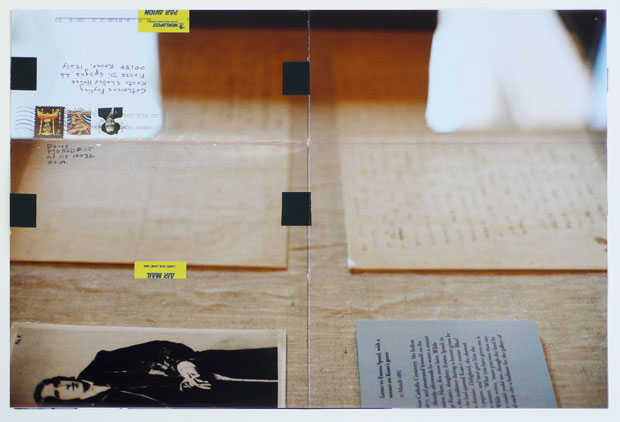
Moyra Davey, The End, 2010 (detail) courtesy the artist and Murray Guy, New York

Moyra Davey, The End, 2010 (detail) courtesy the artist and Murray Guy, New York
An eleventh-floor apartment on Riverside Drive in northern Manhattan. Stately multistory buildings, sloping streets, longtime tenants. “How the Upper West Side used to be.” Sunny rooms, improbably bare in feel despite the jumble of books and framed artworks coating the simple plaster walls: posters by Sister Corita Kent, photographs by Bruce Davidson, Zoe Leonard, Danny Lyon. Furniture has a spartan or improvised quality (which is it? Moyra says both). In the kitchen at rear, a lovingly restored midcentury stove with a griddle and four small ovens sits in an elongated space that evokes rusticity. None of her own photographs, but of course plenty of what appears in them, such as shelves of records topped by old stereo equipment. A sense of being on set, even, for viewers of Moyra Davey’s Les Goddesses, particularly strong when one sees in the back bedroom two bikes and a low mattress, on which Davey leafed through her early photographs in that book-length video.
MW: While it is true that artists in every domain make books, there is a long history of the photobook in particular as a main form of expression, rather than a side project or a record of other works of art. As a photographer, did you come to writing through an interest in making books? What was your first book of writings?
MD: Long Life Cool White (2008). But what got me hooked on writing as part of my working method was editing Mother Reader (2001). I spent a couple of years reading all those texts, shaping the book, and then wrote an introduction. After that, reading and writing became so much more central to what I do.
MW: Were you not reading as much before putting that book together?
MD: I was reading while studying for my MFA, so, targeted theoretical stuff, and then in the Whitney program, also targeted reading. After that I stopped that kind of reading and started
to read literature.
MW: Funny: I stopped reading literature, which had given me all my ideas, once I was through with my undergraduate major in literary theory and had shifted fully into art history. The malformation of the art historian, no doubt: you get impatient with plot and drop the book once you think you’ve understood its underlying structure.
MD: I don’t read so much fiction, but like everyone lately I have been reading Karl Ove Knausgaard (My Struggle, 2012 [English translation]). It took me a hundred pages to get into it, and I frankly didn’t think I would continue—but then halfway through there’s a major dramatic event and I was hooked. He’s like candy now.
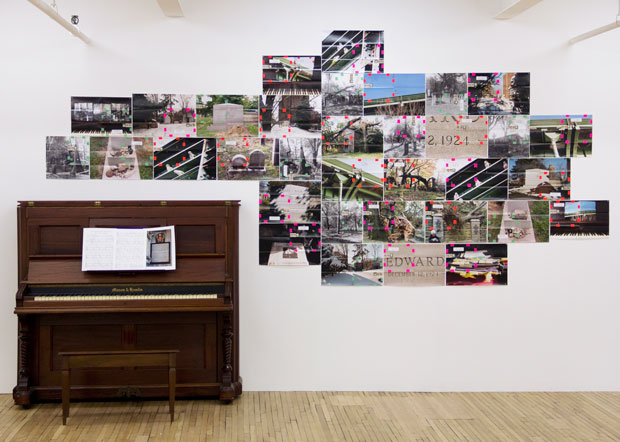
Moyra Davey, Ornament and Reproach, 2012–13 (installation view) courtesy the artist and Murray Guy, New York
MW: What’s his style?
MD: Endless description. You have to imagine that the guy has a photographic memory. Run-on pages of mundane but fascinating details of his life, conversations recorded, and, here and there, digressions on figures like the poet Friedrich Hölderlin, or jabs
at post-Structuralist theory. It’s amazing.
MW: Is it the sort of thing where he tries to keep an impersonal voice, so that meaning comes out of an endless accumulation of facts?
MD: He has a slightly caustic voice, a bit misanthropic, ever so slightly, and maybe that’s what keeps it impersonal. Although he does express a lot of emotion, a lot of grief. I want to think more about how he does it, because it interests me.
MW: You’re building your craft as a writer …
MD: I am, yeah, slowly. I’ve never taken a writing class, though, in my entire life. I’ve always been a very reluctant student, in photography as well. Impatient. Always thought of myself as a bad student. If Eileen Myles were teaching a poetry class, though, I would jump on that. I know she has done that, back in the day.
Getting back to structure: I know it’s important. For someone to want to read something, there has to be some glue, a raison d’être, but yet I resist it. To read any piece of writing or see a movie that does the full circle thing is very satisfying—the closure, the return—but for some perverse, stubborn reason, I avoid it.
MW: And yet your video Les Goddesses is beautiful, like a nineteenth-century novel. Expansive yet incredibly tightly composed. It does have closure of a sort, and it employs many novelistic attributes: lengthy narration, the introduction and development of characters. It also has the symmetry
of a return at the end to what comes in the beginning.
MD: I guess it does. It starts and ends with still photographs.
But I did that almost unconsciously.
MW: Yes, we begin the film by looking at your photograph
of your sisters in the early 1980s, standing, as you say, like caryatids, and then at another that shows two of them, Jane and Kate, lying on the grass—but in voice-over you are talking about the Wollstonecraft family. Literature and photography are held up for comparison and further analogized to the relation of still and moving images.
MD: And to mise-en-scène versus documentary photography.

Moyra Davey, Seven, 2014 courtesy the artist and Murray Guy, New York
MW: These comparisons are not parallels, not sets of lines
that never touch. Instead, you’ve polluted relations, crossed the lines. Nor is the content exactly pure: sex, drugs, debauchery!
MD: Yeah, I think I’m going to do a part two. Things have happened in my family since I made that video. Jane’s youngest daughter, Hannah, overdosed on fentanyl, a synthetic opiate. Very potent. She was nineteen. She’s in the last video I made, My Saints (2014).
MW responds with surprise and momentary upset at the revelation. MD’s voice remains steady.
Hannah hid it so well. When you see her in My Saints, she’s chatting, ebullient; you would never suspect she was on downers. There were signs, but a lot of people missed the signs. That and other things make me want to—[emphatic] Matt, I could revisit that entire video and remake it totally differently.
MW: A rewrite then. Habits of writing give you certain license, I think, that for better or worse you don’t get in the visual arts. Published revisions are a normal part of the writing process. A fictional story—or an art history essay—
can start its public life at a reading, then become a magazine article, a contribution to a multi-author anthology, and after, a chapter in a book. What would you revisit if you did remake the video?
MD: Les Goddesses was kind of a love letter to my family. I think I idealized them. Everything in it is true, of course. But a lot is left out, which is one reason I term those videos “auto-fiction.” Remaking the work, I could do something much grittier. I didn’t show the family as they are now, for instance—
MW: Would you then be putting people back in the work?
In Les Goddesses you treat the living human figure literarily, but not pictorially. The video shows photographs of your family only from your earliest years—pictures that you showed no more than one or two times before “giving up” taking photographs of people around 1985.
MD: I actually videotaped my sister Jane walking, talking, smoking cigarettes in the park. But I don’t know if I’d have the guts to pursue that kind of thing. The remove and control you have working with still photographs is pretty great. Although, My Saints is made up of interviews with friends and family. So maybe I’m a step closer to filming my siblings in the flesh.
MW: You do have remarkable formal means to bridge the gap between photography and writing. The mailers, for example: these are recent photographic grids of yours, the prints for which you have printed on heavier, coated paper, then folded and sent by post to friends and colleagues. The individual images (ranging from a handful to several dozen) are gathered together for display as a composite wall work. Their address and your own are plain to see, covering the images, along with adhesive tabs that were used to hold the folded photograph flat in the mail. They, too, are love letters, sent only to those you know.
MD: Here is one I made showing my sisters, derived from a group photo taken around 1971. We all have that hippie look. It’s called Seven (2014), based on a J.D. Salinger character who is one of seven siblings. It’s funny because, other than Catcher in the Rye I don’t really like Salinger…. After I made the photo piece, I dug up this clever, sniping letter from one of my sisters, sent to me when I was in Paris in 1977, describing all the shenanigans going down with my siblings in my absence. And it was exactly seven pages long, a perfect match. I photographed each page separately and concealed her name to protect her privacy, though I doubt she’d care.
MW: Fragments of writing, on the one hand, and fragments of a picture on the other hand. It should be pointed out that the pictorial fragments don’t divide neatly—we see parts of one or more sisters in each of the (nine) parts of the family photo mailer—whereas your mailer of the one sister’s letter does appear as a single sheet per picture.
MD: Except that parts of the writing are covered with stamps and labels and tape, so you can’t read everything. You can read passages but not all of the writing.
MW: It’s another way of revising: covering over. Hiding and revealing simultaneously seems to be your way of coming to terms with a sort of confessional self-expression.
MD: It is confessional, but I’ve found distance through a certain dispassionate, dissociative stance. I feel simultaneously that it’s me and not me writing and performing this material. It would be a good challenge now to make a video where the faces are no longer pretty.
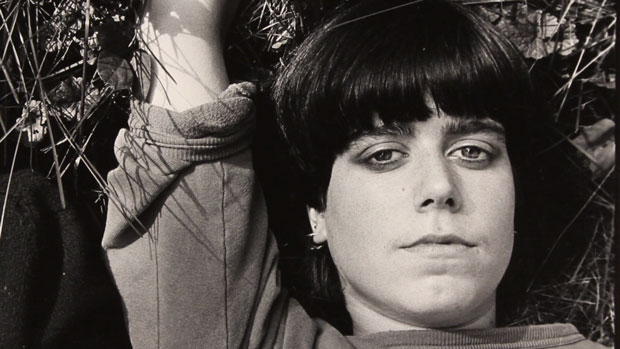
Moyra Davey, Video still from Les Goddesses, 2011 courtesy the artist and Murray Guy, New York
MW: You’ve quoted a line from Jean Genet, saying I’m fifty and I look like sixty, and I think that’s fabulous …
MD: He says, I’m not ashamed.
MW: Right, and he’s writing to this young man, Java.
MD: His former lover. And he adds, “I even find it rather restful.”
MW: Yes, I’m amazed I forgot that bit of the quote, because it is beautiful. Restful: what a perfect word. A whole lot of youthful energy is expended in making oneself presentable.
MD: And middle-age energy too. In a section of My Saints titled “Vanity,” I start with a line about the “bleaching white light of vanity,” and then enter the frame, my face sun-bleached out. Later I go to “Vanitas,” a view of one of my nieces, who has a tattoo of her skeleton on her back—all the bones—wait, I have to get you the picture to show you…
Walks away. A half-minute of silence while she searches.
MW: This is an incredible picture, your niece, her skeletal structure imprinted on her skin. Like wearing your own X-ray—more questions of how to articulate structure and content. I was about to ask how you structure the making of your videos, whether you follow conventions of scripting or storyboarding.
MD: I don’t storyboard, but I always write something. I wrote this text (Burn the Diaries) and thought it was going to be the video (My Saints). Then I started to perform it and realized that I need to get others in front of the camera to make this work.
I do appear in the one scene, and I’m heard off-camera pretty regularly. There’s a lot of talking but also text—rolling and static. That was a device I set out to use from the onset as a way to modulate the spoken word.
MW: You ask viewers to look at language and read it as well. Unlike many career writers but like a lot of visual artists interested in language, you seem fascinated by the material objects and paraphernalia of writing.
MD: I love paper, and I have fountain pens, and I love soft pencils; but the only way I can seriously compose anything is on the computer. Actually, I really began writing only when I met Jason [Simon, a filmmaker], in 1986, and he had a little Mac. It was so much more accessible to me to type on that.
MW: When I read your books now, I hear your voice, not my own. You read more slowly aloud than I do when reading to myself, so I slow down to accommodate what I remember as your cadences and pauses. It’s an odd feeling, having another voice in my head.
MD: When I sit down to write something, my instinct is “start with the most pressing thing.” Then I go to the notebooks, read through them systematically and pull out anything of interest. And then build on those extracts. You know what I would like to do: write without intertitles. That would be a good challenge, because using intertitles is a very easy way for me to write, in short fragments. Having the intertitles gives my writing a de facto structure.
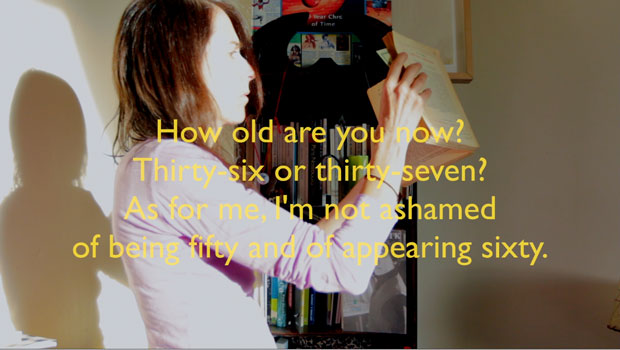
Moyra Davey, Video still from My Saints, 2014 courtesy the artist and Murray Guy, New York
MW: I just assumed you used intertitles out of a persistent love for Walter Benjamin.
MD: Yes, and Roland Barthes. But it is a bit of a crutch.
MD and MW each get up to fetch something for the other. MW returns with a small book of pictures and quotations from Japanese photographer Shomei Tomatsu.
MW: There were just a few copies printed of this book after
a show that we did last fall, which in its concept was intended as a book on a wall. The installation had writings interspersed with photographs, in quotations printed at the size of a standard 11-by-14-inch photograph; text as image and also
as the equal of images. He was a brilliant writer, I think. It was an especially meaningful show for me, largely because of the importance of his dual practice as writer and photographer.
MD: Thank you for this!
Speaks as she leafs slowly through the book.
I have his book [Chewing Gum and Chocolate, Aperture, 2014] and have just started reading it. You can tell right away he had the knack, a natural scribe. It’s so unpretentious, so unassuming, but so observant of what is going on around him, and of himself, his own position in that postwar world. Writing that’s a little bit elliptical, running on a parallel track to the photographs yet intersecting at points with them.
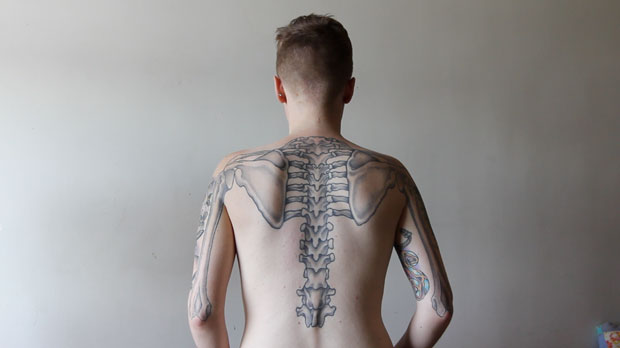
Moyra Davey, Video still from My Saints, 2014 courtesy the artist and Murray Guy, New York
MW: When you think about it, for all the emphasis on book- making in photography—and that is where we started this afternoon—there seem to be relatively few photographers who give themselves seriously to writing. Tomatsu is unusual in that sense. Maybe it’s a further sign of his promiscuity,
a word you’ve used lately as well. Tomatsu moves in and out of straight documentary photography, but he also likes montage, he likes abstraction, he likes mixing color and black and white … and he likes to write, and even to test different voices, from the statistical to the emotional, the novelistic
to the epistolary. His great midcareer retrospective book I Am a King (1972) has at its center a section on the height of the student protests, in 1969–70, and in this section he pairs photographs with a month’s worth of diary entries. In short, Tomatsu does not mind being literary. That’s true right from his start in magazines at the tail end of the 1950s and early 1960s. This is very unlike his near-contemporary Robert Frank, whose book The Americans (1958–59) depended for its words on Jack Kerouac. It’s even further from the classic photobooks of the 1920s and ’30s, in which photographers’ efforts were often framed with essays or statements by hired critics. Although there are many more examples of photographer–writers in recent decades, an extensive literary commitment such as yours remains unusual.
Of course there is still the question of whether anyone reads.
MD: Living with a seventeen-year-old boy who only wants to leave the house with his phone (permanently outlined on his thigh) and his wallet—won’t carry a book—it’s a question we ask here every day. He listens to music, and he reads challenging stuff for school, but he stopped reading for pleasure once electronics entered his life. I, on the other hand, should devote more time to listening to music.
[Conversation continues.]
_____
Matthew S. Witkovsky is Richard and Ellen Sandor Chair and Curator, department of photography, the Art Institute of Chicago. photography is now celebrating its fortieth anniversary as a curatorial department with a series of presentations from the permanent collection, including a room devoted to work by Moyra Davey.























